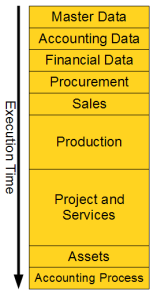A new major release is coming! On March 31st, 2011 the Openbravo ERP 3.0 is planned to see light.
It will come with several changes both Functional and Technological. The new release will have tons of cool features and a huge GUI redesign is planned… and this is good news, isn’t it? Well…
My first thought when I saw the mockups for new layout was “Yikes! This will be hard to implement in Selenium“.
From a strict Quality Assurance point of view, new stuff means more potential problems. Even if considering only our Smoke Test forgetting the rest of the testing cycles we do, it is clear that most of the test cases will require hard work in order to update them. And from the Automation side, there are even more issues.
But a moment later, my mind changed to “Wait a minute! We can do this. It is a challenge and challenges are the actual motivation for the team“. These mixed feelings are caused by the difficulties we expect to have along the new Automated Test development. Test cases do not playing the proper test steps and things like that.
However, those are actually the things that help us (to both QA Team as a unit and Openbravo as a company) to improve previous processes.
So the objective is to develop a fully functional Smoke Test and automate it to run against Openbravo ERP 3.0. In order to achieve the goal, we have identified several tasks.
- Design of new Smoke Test
- Test cases review
- New flows review
- New suites organization
- New test cases development
- Test cases review (part 2)
- Test case validation (with other teams)
- Design of new Automated Test
- Classes (foundation) review
- Diagram design (high level)
- Component design (low level)
- Prototyping
- Deliverables testing
As we said in previous posts our expertise in Selenium is increasing rapidly. We are currently able to perform several types of tests and make reliable and fast test suites.
There are two main development lines that run in parallel, the Functional branch is intended to develop the test cases in Testlink according to the new flows that will be delivered in 3.0. Partially depending on this Functional, there is the Automated branch that will focus on Selenium issues.
One of the most evident features in 3.0 is the GUI redesign, and that means a direct hit in our foundation classes for automated tests. Furthermore, the use of a framework as Smartclient is a major drawback since from a plain HTML perspective the application is completely different from the 2.50 series.
As a conclusion, this post’s title should be changed to “Openbravo 3.0: What a great moment to develop more Selenium stuff!“



